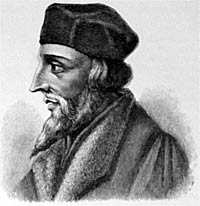In 1415, a Czech priest named Jan Huss was condemned and
burned at the stake for heresy against the Roman Catholic Church. Jan was, in
fact, one of the first of the great Church reformers who stood up against
corruption in the Church, what he saw as extra-Biblical practices, and church abuses.
Before this time, heretical factions that were persecuted by the Church would
eventually melt away, but in 15th century Bohemia the story was
different.
 |
| Jan Huss |
When news of the death of Huss spread throughout Bohemia,
the people were outraged. Huss had gained many followers, knights and common
people alike, who were tired of Church abuses and the death of their leader meant
naught but persecution for them, as well. Protests broke out and a radical
event unfolded in the city of Prague when supporters of Huss, now called
Hussites, took a burgomaster and some council members and threw them out the
second story window of the town hall. This “Defenestration of Prague,” as it
came to be known, sent a shock through Bohemia and Moravia that literally killed
the Catholic King Wenceslas by way of a heart attack. This power vacuum gave
the Hussites time to organize. With full knowledge that the Church wouldn’t sit
idly by, the Hussites developed a spectacular war strategy. They came up with a
war wagon system in which carts were drawn up in a defensive circle and hand
gunners and pike men defended the circle from the protection of the armored
wagons. This strategy was particularly
effective against the mounted cavalry of the late Middle Ages and the Hussites
gained a fierce reputation for battle prowess.
 |
| Hussite wagon circle |
When the Papal crusade arrived at Prague, the Hussites were
forced to negotiate. However, once the Imperial armies withdrew, the Hussites
continued to capture fortresses and consolidate their base. Indeed, they would withstand three crusades led
against them by the Germans and the Church. Despite the repeated attempts of
their enemies, the Hussites were able to maintain nominal independence and
worship in their own manner.
 |
| City of Prague |
When the larger Protestant Reformation broke out, the Hussites
continued their traditions and joined the larger movement as Protestants. Even
to this day, the Czech people are proud of a heritage of standing up for your
beliefs and resistance to outside control. Jan Huss and the succeeding Hussites
were indeed a reformation before the Reformation.

Good for the Czechs!
ReplyDelete